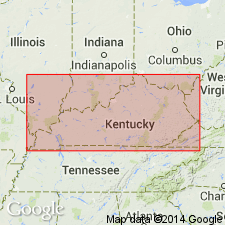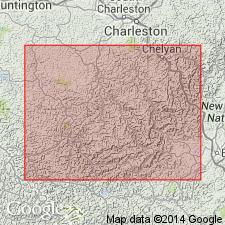
- Usage in publication:
-
- Dingess [Shale Member]
- Modifications:
-
- Revised
- AAPG geologic province:
-
- Appalachian basin
Summary:
Shown on correlation chart (Plate 8) as replacing Kendrick Shale Member at the base of the Hyden Formation (new) in the VA and WV portion of the Cumberland plateau. Unit, however, is not discussed in text.
[GNU remark (August, 18, 1994, GNU records, USGS DDS-6; Reston GNULEX): Because of limited documentation, assignment to Hyden Formation is not considered a formal revision by the GNU at this time.]
Source: GNU records (USGS DDS-6; Reston GNULEX).

- Usage in publication:
-
- Dingess Shale Member*
- Modifications:
-
- Revised
- Redescribed
- Dominant lithology:
-
- Shale
- Siltstone
- Sandstone
- Limestone
- AAPG geologic province:
-
- Appalachian basin
Summary:
Dingess Limestone was originally described as part of former Kanawha series by Hennen and Reger (1914) in Logan and Mingo Cos. as gray to brown, hard, siliceous, lenticular, locally ferriferous, and fossiliferous limestone, 0 to 5 ft thick. Here redefined as Dingess Shale Member of Kanawha Formation, a thick sequence of marine shale, siltstone, and sandstone that contains discontinuous nodular limestone bed or concretions near its base. Dingess is a useful stratigraphic marker bed that Hennen and Reger mapped throughout both counties and identified in many other parts of southern WV. Dingess also traced from Winifrede Junction in Kanawha Co., southeastward to Tug Fork (Hennen and Reger, 1914). Drill-hole data, reconnaissance mapping, and faunal analyses (T.W. Henry, 1988, oral commun.) now suggest that section near Dingess, described by Hennen and Reger, is actually the younger Winifrede Shale Member (here formalized) of the Kanawha Formation. In order to avoid confusion, an area about 16 mi south of Dingess, between Williamson and Matewan (7 mi southeast of Dingess) is designated the type area for the Dingess Shale Member. This is an area of uncomplicated structure, where the member is generally fossiliferous and as much as 80 ft thick. Easily identified there as medium- to dark-gray, silty to sandy clay shale directly overlying extensively mined Williamson coal bed. Correlated with Kendrick Shale member of Breathitt Formation in KY based on their position above Williamson coal bed. Age is Middle Pennsylvanian. Report includes correlation charts and columnar sections.
Source: GNU records (USGS DDS-6; Reston GNULEX).
For more information, please contact Nancy Stamm, Geologic Names Committee Secretary.
Asterisk (*) indicates published by U.S. Geological Survey authors.
"No current usage" (†) implies that a name has been abandoned or has fallen into disuse. Former usage and, if known, replacement name given in parentheses ( ).
Slash (/) indicates name conflicts with nomenclatural guidelines (CSN, 1933; ACSN, 1961, 1970; NACSN, 1983, 2005, 2021). May be explained within brackets ([ ]).

